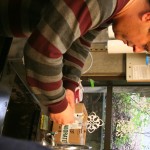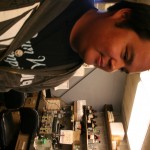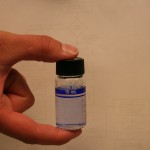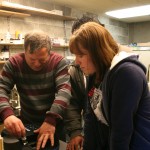Beam Reach and the Gato Verde had an excellent opportunity this term during the Beam Reach program. A film crew and a producer of the Show “Orca: The Sea Wolf†came aboard the Gato Verde to do some filming of the program and mainly Orcas and communication. Alexis, a producer from Pangolin Pictures, came aboard on May 27, 2009 around nine at night. She gave us release forms to sign and then she went to bed after a long day. Then in the morning Jeff, the cameraman, and his wife Kim came aboard. They started to film us releasing the boat, heading out, and our normal routine with getting updates on the whales. I got to make a phone call to Mark Mallison, a contact in Victoria, and have the entire conversation filmed. Then once we were out, Erica and Matt did some hydrophone deployment, got many shots of the Gato Verde, and us searching for the whales. It was a pretty cool day, and we all can’t wait until we get updates on the show and when it is going to air! We are going to be in a small portion on the Discovery Channel! That is so cool and we are super excited! It was a great experience to have because we got experience the world of entertainment of a bit and got a peak into what our futures are going to be like we ever get filmed again. Plus it was excellent advertisement for Scott, Beam Reach, and the Gato Verde! That is always a good thing! A new learning experience was gained with this experience and along with the many more from this program.
Read More
       Surfactants are used in our everyday life, whether we are washing our hands to our hair, cleaning dishes, or cleaning clothes. Surfactants play an important role in our everyday life as humans. Surfactants work by having a hydrophilic head, which loves water and a hydrophobic tail, which hates water. What makes it so useful is the fact that the hydrophobic tail will leech onto all the oil and grease we on household items and on ourselves. Then when each of the tails form a core that encloses an oil droplet, this is called a micelle. This makes both of each end of a surfactant happy. What is useful to humans is causing harm to fish and other inner tidal organism.
           Erica and I, as Beam Reach students in the spring 2009 term, have decided to measure the surfactants that the program releases into the ocean, while on the Gato Verde. With the help of Dr. Russel Barsh we have created a process of measuring each of the samples we have collected on the Gato Verde.
           This is our process for collecting each sample:
1.    Must be 48 hours before we run the test, if it sits to long the sample turns bad.
2.    Rinse syringe three times in sample test water
3.    Attach the filter to the syringe
4.    Filter out the sample and place into a clean container
5.    Place in the refrigerator to keep cool
Once we get back to the Friday Harbor Labs and meet Russel, here is the sample
testing process:
1.    Dilute the sample: 1mL of sample to 99mL of nano pure water.
2.    Scan the blank sample
3.    Add bicarbonate of soda to bring the pH up (used as a buffer)
4.    Add sodium chloride (salt) to bring up the density of the water.
5.    Add 2mL of methylene blue and toluene mix
6.    Mix for 1 minute to allow the formation of micelles
7.    Let it sit for 5 minutes
8.    Shoot the sample
9.    Read the Results
Our results with the four samples we have taken are:
1.    1st grey water sample: 1.7 ppm (2 gallons of water with 2 squirts of joy soap)
2.    2nd grey water sample: 5.5 ppm (4.5 gallons of water with 2.5 squirts joy soap)
3.    Roche Harbor: 0.3 ppm
4.    Mitchell Bay: 1.5 ppm
Most of these numbers are terrible, because 0.5 ppm is lethal to fish and inner
tidal organisms. Some of the effects are disrupting gas exchange across the gill, which clogs up oxygen exchange, and it suffocates the fish. It can also clog pours and disrupt membranes in crustacean causing the membrane to burst. If surfactants are doing damage to fish, how can that affect the SRKW? Our best option right now is to use less, but still find a efficient way to be clean! Remember the saying less is more.
Â
Best Wishes,
PeterÂ
Â
PS: Thank You Dr. Russel Barsh for helping us in the lab and informing us about surfactants and its effects!  Â
Â
Â
Â
Â
Â
Â
Â
Read More
Being in new places means meeting new people. Last weekend Hannah and I met some very interesting people who are members of Sea Shepherd. I had never heard of this group before we met them and it has been interesting reading about their history and some of the things they have done. This organization was established in 1977 as an international nonprofit marine wildlife conservation organization. Their mission is to end destruction of habitat and slaughter of wildlife in the world’s oceans. They have a very innovative direct action methodology in order to put a stop to killing of endangered marine species and ecosystems. They actually confront the offenders on high seas and have been known to sabotage ships and equipment. They have also been known to throw stink bombs onto the ships and in the past even ram into ships in order to disable them. The three main industries that Sea Shepherd targets are: the illegal whaling or killing of dolphins, the slaughtering of seals and the shark finning operations. Crewmembers are all volunteers and pay their own way to get to the ship for each mission but food and the stay on the boat is free. This organization has made many enemies and has been called eco terrorists by some governments. At the same time there have been many governments who have actually asked for their help with protecting patrol boats at times. They have raised a lot of awareness to issues that were not well known to the general public. They have also made a lot of political progress in stopping sealing in some European countries. The controversy lies in their sometimes violent methods. We have had some conversations about the organization, their methods, and their goals. Everyone has a different way of looking at it but we do all agree that they have done some good things and some not so good things. In the last year Animal Planet did a 7 show series titled Whale Wars. This show spread the word to the general public that whaling still occurs today and is not just a thing of the past. Although their sometimes violent methods are frowned upon they have made the public more aware of many issues in our marine ecosystems that need to be addressed.

Read More








 Twitter
Twitter LinkedIn
LinkedIn Facebook
Facebook